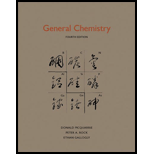
Concept explainers
(a)
Interpretation:
The magnetic behavior of
Concept Introduction:
Bond order of a molecule or ion is calculates by the following formula,
Bond order
Where,
Paramagnetic and diamagnetic compounds:
Paramagnetic compounds have unpaired electrons and are attracted to magnetic field whereas diamagnetic compounds have paired spins and are repelled by the magnetic field
(a)
Explanation of Solution
The molecular configuration of carbon monoxide is,
There is no unpaired electron in the carbon monoxide. Hence it is not a paramagnetic compound.
(b)
Interpretation:
The magnetic behavior of
Concept Introduction:
Refer to part (a).
(b)
Explanation of Solution
The molecular electronic configuration of fluorine molecule is.
There is no unpaired electron in the
(c)
Interpretation:
The magnetic behavior of
Concept Introduction:
Refer to part (a).
(c)
Explanation of Solution
The molecular configuration of
Oxygen molecule has two unpaired electrons so it can act like magnet.
(d)
Interpretation:
The magnetic behavior of
Concept Introduction:
Refer to part (a).
(d)
Explanation of Solution
The molecular configuration of
Since oxygen molecule has two unpaired electrons it shows strong mass shift in magnetic susceptibility balance.
Want to see more full solutions like this?
Chapter 9 Solutions
General Chemistry
 ChemistryChemistryISBN:9781305957404Author:Steven S. Zumdahl, Susan A. Zumdahl, Donald J. DeCostePublisher:Cengage Learning
ChemistryChemistryISBN:9781305957404Author:Steven S. Zumdahl, Susan A. Zumdahl, Donald J. DeCostePublisher:Cengage Learning ChemistryChemistryISBN:9781259911156Author:Raymond Chang Dr., Jason Overby ProfessorPublisher:McGraw-Hill Education
ChemistryChemistryISBN:9781259911156Author:Raymond Chang Dr., Jason Overby ProfessorPublisher:McGraw-Hill Education Principles of Instrumental AnalysisChemistryISBN:9781305577213Author:Douglas A. Skoog, F. James Holler, Stanley R. CrouchPublisher:Cengage Learning
Principles of Instrumental AnalysisChemistryISBN:9781305577213Author:Douglas A. Skoog, F. James Holler, Stanley R. CrouchPublisher:Cengage Learning Organic ChemistryChemistryISBN:9780078021558Author:Janice Gorzynski Smith Dr.Publisher:McGraw-Hill Education
Organic ChemistryChemistryISBN:9780078021558Author:Janice Gorzynski Smith Dr.Publisher:McGraw-Hill Education Chemistry: Principles and ReactionsChemistryISBN:9781305079373Author:William L. Masterton, Cecile N. HurleyPublisher:Cengage Learning
Chemistry: Principles and ReactionsChemistryISBN:9781305079373Author:William L. Masterton, Cecile N. HurleyPublisher:Cengage Learning Elementary Principles of Chemical Processes, Bind...ChemistryISBN:9781118431221Author:Richard M. Felder, Ronald W. Rousseau, Lisa G. BullardPublisher:WILEY
Elementary Principles of Chemical Processes, Bind...ChemistryISBN:9781118431221Author:Richard M. Felder, Ronald W. Rousseau, Lisa G. BullardPublisher:WILEY





